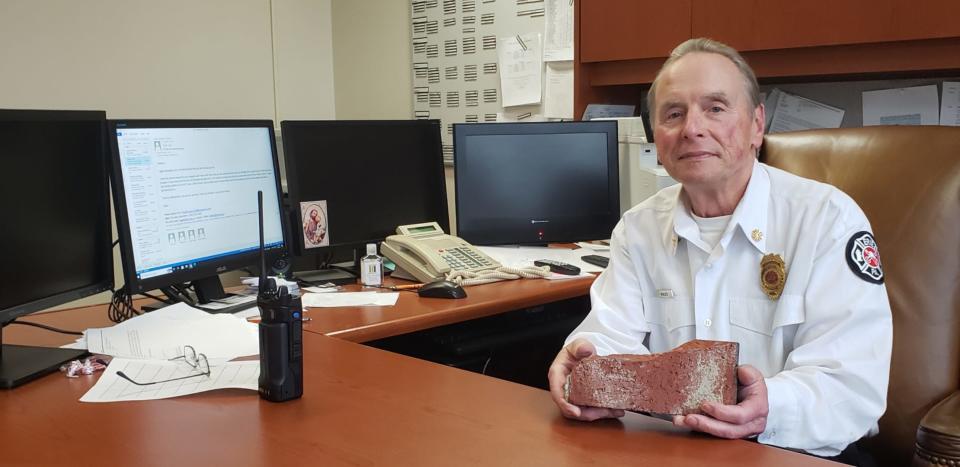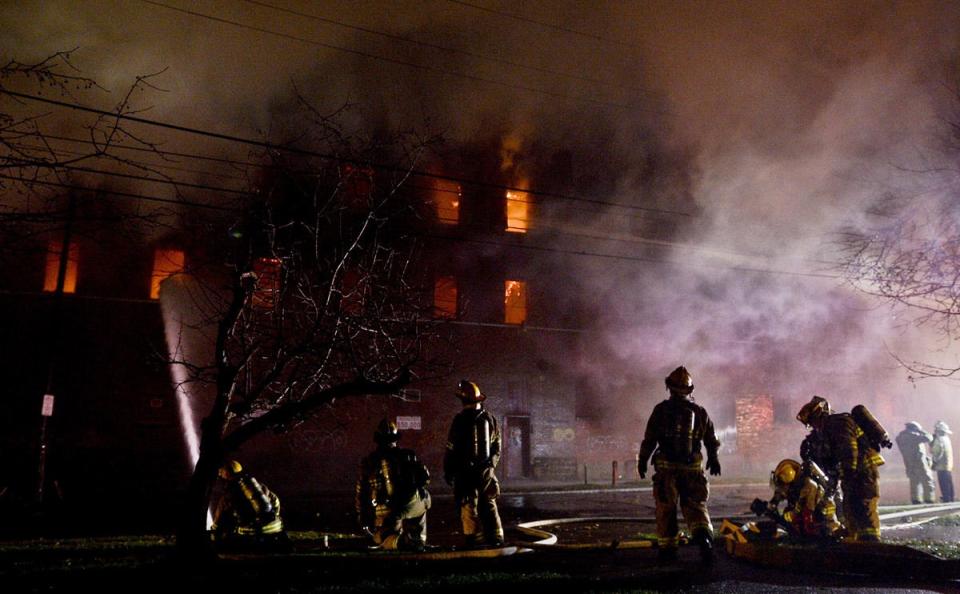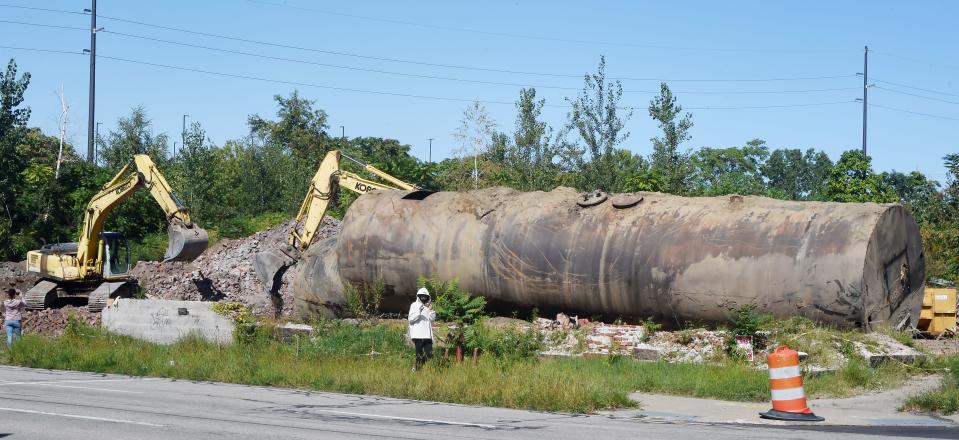Joe Walko didn’t need a relic of how treacherous the crumbling Quin-T complex on Erie’s east side had become over the years.
But one day while visiting the property, Walko grabbed a memento anyway.
After work crews first started demolishing portions of the Quin-T site at East 16th and French streets in 2016, Walko, who at that time was the Erie Bureau of Fire’s chief, stopped by to pluck a red brick from the debris.

Most of the demolition was completed in 2021 after the Erie County Redevelopment Authority purchased the building with an eye toward revamping the property.
That keepsake sat for years inside Walko’s fifth-floor office at Erie City Hall, a symbol of the risks he and other city firefighters regularly faced at the vacant industrial site.


Between 2013 to 2016, according to the Erie Bureau of Fire, city firefighters responded to nearly 20 fires at the Quin-T property that were either accidentally or intentionally set. In some cases, firefighters fought the fires exclusively from the exterior because of safety concerns.
No firefighters were seriously injured battling the Quin-T blazes.
“When a call came in for that building, we were immediately very concerned,” said Walko, now 69, a 40-year city fire bureau veteran who retired in early March.
The Erie Times-News reported in July 2023 that, for decades, tons of potentially dangerous materials were left inside both the dilapidated, unsecured Quin-T site and another vacant industrial property the county Redevelopment Authority owns, the former Erie Malleable Iron site at 603 W. 12th St.
Danger zones: Asbestos, toxic chemicals among hazards left at Erie’s Quin-T, EMI sites
Materials left at the properties include asbestos and chemicals or substances that have been linked to various cancers.
“It was a big structure. Most of the fires occurred or were reported at night,” Walko said. “We knew it was unstable. We knew homeless people were at times living in there. The floors had big gaping holes in them. There were all kinds of chemicals and stuff inside. With that building you were always worried about firefighter safety.”
Asked why he wanted that brick, Walko said: “Because we spent countless hours there. It’s a reminder that a lot of times, with some fires and in some buildings, you’re working at a deficit from the minute you arrive.”
Quin-T property: A timeline of environmental, safety concerns
‘Problem site’
Long before backhoes and wrecking balls arrived at the Quin-T property, Erie firefighters, code enforcement officials and regulatory agencies like the Department of Environmental Protection and the U.S. Environmental Protection Agency were mindful of the potentially dangerous state of the sprawling 4-acre complex, at 160 E. 16th Street.
Those agencies had taken various legal and regulatory actions against the property’s owners over the years, either looking to have the crumbling property made more secure, pointing out alleged safety violations or seeking to have potentially hazardous materials identified or removed from the property by the complex’s owners.
Some of those issues, according to documents and interviews, included
-
an EPA citation for Quin-T’s parent company at the time for violating federal asbestos regulations at the plant;
-
the DEP taking action in Erie County Common Pleas Court to force two Quin-T-affiliated entities to identify and dispose of the contents of more than 100 drums at the factory;
-
city of Erie officials in 2014 demanding that the owners make the property safer after multiple fires at the site; and
-
the city filing a number of code enforcement violations against Quin-T’s owners in 2015, which were later withdrawn.
The Quin-T buildings date to 1890, according to Erie County property records. The complex originally operated as the Watson Paper Co., manufacturing building and roofing materials and pipe and boiler coverings, among other materials.
GAF Corp. also operated out of the site for decades before Quin-T’s ownership. Quin-T produced asbestos millboard, a cardboard-like product that can be inserted between metal to produce gaskets.
Tina Mengine, the county Redevelopment Authority’s executive director, said that once the agency acquired the Quin-T property and began a preliminary site assessment, authority officials “quickly began to understand the enormity of what we were taking on. We started to understand why other agencies and the city of Erie had had concerns about the property for a long time.”
An entity known as 140 E. 16th St. Inc., of Depew, New York, sold the Quin-T property to the Redevelopment Authority in 2021 for $10,000, county property records show.
Mengine described the parcel as a “problem site that was of great concern to the community and the neighborhood,” in large part because of the property’s dilapidated condition and the materials that had been abandoned inside.
The site is located in a residential neighborhood, across the street from public housing units.
“The potential dangers that had been expressed over the years, by many, were actually the primary reason we acquired the site,” Mengine said.
“I think that what we’re recognizing in this community now is that we’ve allowed too many industrial polluters to operate for too long with little consequence. And too often this occurs in poor neighborhoods,” Mengine said.
The Times-News reported in December that soil and groundwater testing at the Quin-T property revealed that portions of the property are contaminated with potentially harmful chemicals including arsenic and lead.
The Redevelopment Authority has entered into a $142,683 purchase option agreement with Erie’s Perseus House Charter School of Excellence for the Quin-T property for an expansion of its campus and programs, including a gymnasium, event space, outdoor soccer and athletic fields, an outdoor kitchen and other amenities.
The school, headquartered at 1511 Peach St., is near the Quin-T site.
However, that purchase is contingent upon a full state-sanctioned environmental cleanup at the property.


The Times-News reported in May that the EPA has awarded a $5 million cleanup grant to the Enterprise Development Center of Erie County, an affiliate of the county Redevelopment Authority, for continued environmental remediation at both the former Quin-T and EMI sites.
The money will be used for continued environmental cleanup at both properties, as well as “community engagement activities” related to those redevelopment projects, according to the EPA.
Former Quin-T employee: Company’s owners ‘had some responsibility’
Terry Fuller worked at the Quin-T complex as a quality control and research manager for both GAF Corp. and Quin-T between 1976 and 1994.
“I can’t understand how someone could let that happen and leave all those materials in there,” Fuller said during a recent interview at his Summit Township home. “It would be like me abandoning a house with dangerous things inside. And I would say that, yes, the former owners had some responsibility to take care of that.”


A former Hammermill Paper Co. employee and Boston University graduate with a degree in biology, Fuller said the company manufactured roofing materials, gaskets and other products during his time there. He helped maintain the plant’s quality standards and created laboratories to conduct product and materials testing, among other duties.
“At any time we had 1,000 tons of asbestos in that plant,” Fuller said. “For a long time It was common for people not to wear masks. You used to smoke in the plant. It was a different time.
“We worked hard to try to keep things safe and make sure the machines and the products and everything else was handled correctly,” Fuller said.
Fuller said he was eventually fired from Quin-T when the owners wanted to cut management costs, and he did not feel that his termination was justified. He went on to work for other local manufacturing companies before retiring.
He’s pleased to see redevelopment happening at the Quin-T site.
“In my mind, the way the world should work is, you can’t just leave a site sitting like that,” Fuller said.
Coming up in the Erie Times-News:
∎ The EMI property was rapidly deteriorating for decades along the West 12th Street industrial corridor while potentially harmful chemicals and toxins sat inside, unsecured.
Contact Kevin Flowers at [email protected]. Follow him on X at @ETNflowers.
This article originally appeared on Erie Times-News: Quin-T property in east Erie posed various dangers for years
Source Agencies


